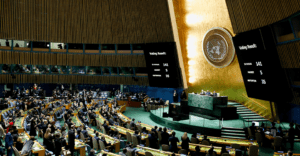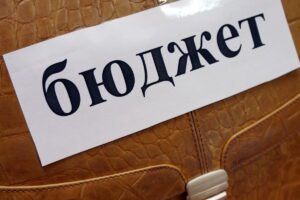
The UN General Assembly adopted a resolution on respect for the territorial integrity of Ukraine, which also condemns the attempt of the Russian Federation to annex the temporarily occupied territories of Donetsk, Luhansk, Kherson and Zaporozhye regions of Ukraine.
The resolution calls on countries not to recognize Russia’s claims to the four regions of Ukraine claimed by Russia after the so-called referendums held late last month, and demands that Moscow change course from an “illegal annexation attempt,” according to a press release posted on the website. UN.

The resolution, “protecting the principles” of the UN Charter, notes that the Donetsk, Kherson, Lugansk and Zaporozhye regions are temporarily occupied by Russia as a result of aggression, violation of the territorial integrity, sovereignty and political independence of Ukraine.
The General Assembly automatically brought the resolution to the discussion caused by Russia’s use of the right of veto in the Security Council in connection with the attempted annexation.
The resolution adopted by the Assembly calls on all states, the UN and international organizations not to recognize any claims of Russia for annexation and demands the immediate cancellation of its application for annexation. The resolution welcomes and “expresses strong support” for the continued efforts of the Secretary-General and Member States to de-escalate the current situation in search of peace through dialogue, negotiation and mediation.

According to the broadcast from the General Assembly hall, 143 out of 193 participants voted in favor, 35 countries abstained (Algeria, Armenia, Bolivia, Burundi, Central African Republic, China, Congo, Cuba, Eritrea, Eswatini, Ethiopia, Guinea, Honduras, India, Kazakhstan, Kyrgyzstan, Laos, Lesotho, Mali, Mongolia, Mozambique, Namibia, Pakistan, South Africa, South Sudan, Sri Lanka, Sudan, Tajikistan, Thailand, Togo, Uganda, Tanzania, Uzbekistan, Vietnam, Zimbabwe), voted 5 against (Belarus, DPRK , Nicaragua, Russia and Syria).

First Deputy Chairman of the Verkhovna Rada Oleksandr Kornienko invited Oman to consider the possibility of participating in the restoration of Ukrainian regions affected by Russian aggression.
According to the press service of the office of the Verkhovna Rada, Kornienko made such a proposal during a meeting with a delegation headed by Chairman of the Advisory Council of the Sultanate of Oman Khalid Al-Maawali at the site of the Assembly of the Inter-Parliamentary Union in Kigala (Rwanda).
He also called for the creation of inter-parliamentary friendship groups.
“The creation of inter-parliamentary friendship groups will be an important first step to enhance cooperation between the legislative bodies of Ukraine and Oman,” Kornienko said.
The First Deputy Speaker of the Ukrainian Parliament invited members of the Omani delegation to take part in the first parliamentary summit of the Crimea Platform in Zagreb at the end of October.

The international reserves of Ukraine as of October 1, 2022, according to preliminary data, amounted to $23 billion 929.6 million (in equivalent), which is 5.9% less than at the beginning of September ($25.436 billion), according to the data of the National Bank of Ukraine, released on Thursday.
“As of October 1, 2022, Ukraine’s international reserves, according to preliminary data, amounted to $23.929 billion. In September, they decreased by 5.9%, taking into account the sale of foreign currency by the National Bank on the interbank market, including to meet defense needs and payments of Ukrainians abroad. At that At the same time, steady receipts from international partners continue to keep international reserves at a sufficient level, despite a full-scale war,” the regulator explained.
The regulator clarified that net international reserves in September decreased by 4.6%, or $736 million, to $15.181 billion, while in August their growth was 26.6%, or $3 billion 342 million (to $15.917 billion).
According to the National Bank, in September the dynamics of international reserves was affected by operations to manage public debt. In particular, foreign exchange receipts to the accounts of the Ukrainian government with the NBU in September amounted to $2.034 billion, including from the United States – $1.5 billion, from the EU – $482 million, from the placement of government bonds – $51.7 million.
The total volume of board payments for servicing and repaying state debt in foreign currency amounted to $65.1 million, including $63 million directed to repay debt to international creditors, $2.1 million – to service government bonds.
In addition, Ukraine transferred $624.6 million to the IMF.
International reserves were also affected by NBU operations on the interbank market. In particular, they sold $2.777 billion on the foreign exchange market and bought $39.4 million into reserves, due to which the balance of interventions was negative and amounted to $2.728 billion.
In addition, the reserves were affected by the revaluation of financial instruments, in particular, their decrease by $115.5 million.
“The current volume of international reserves provides funding for 3.7 months of future imports, which is enough to meet the obligations of Ukraine and the current operations of the government and the National Bank,” Certrobank said.
As reported, at the beginning of 2022, Ukraine’s international reserves amounted to $30.941 billion, net international reserves (NIR) – $20.767 billion.

The Organization for Economic Co-operation and Development (OECD) will open a dialogue with Ukraine on its accession following a request from Kyiv, OECD Secretary General Matthias Kormann said in a statement on Wednesday.
“After a request received from Prime Minister Denys Shmyhal to start the process of Ukraine’s accession to the OECD, the OECD Council decided to recognize Ukraine as a potential member of the organization,” it says.
Norman noted that after the completion of initial consultations on this issue, the OECD Council will consider opening discussions on accession and preparing a draft roadmap.

The government of Ukraine plans to attract $37.9 billion to finance the state budget deficit and $13.6 billion for restoration, the largest contribution is expected – $18 billion and $6.5 billion respectively – from the United States through USAID, such data are given in the presentation of the project state budget-2023.
According to information on the website of the Ministry of Finance, it is assumed that assistance from the United States will be monthly: for the budget – $1.5 billion, and for recovery – from $0.4 billion to $0.6 billion.
The second most important source of budget financing in the presentation is the IMF – $ 15 billion: $ 2 billion each in January, February and September, $ 1.6 billion in June, $ 0.6 billion – in August and from $ 0.8 to 1.1 billion – in the rest months.
As for macro-financial assistance from the EU and other sources, it is expected to be restored in the amount of $7.1 billion – monthly at $0.6 billion, except for $0.5 billion in December. While state budget funding from this source is projected at $4.9 billion: $1.9 billion in the first quarter, $1.3 billion in the second, $0.2 billion in the third and $1.3 billion in the fourth.
Finance Minister Serhiy Marchenko specified that this year, as part of negotiations with international partners, Ukraine has already received $19 billion in financial support, of which almost 50% is grant funds.
“By the end of the year, we plan to raise about another $17 billion in additional funding,” he said, presenting the draft state budget in the Rada on Wednesday.

The project of Ukraine, a warring country, for 2023 was developed by the Ministry of Finance and supported by the Cabinet of Ministers, said Finance Minister Serhiy Marchenko.
“The 2023 state budget is the budget of a country that will become stronger, strengthen its defense capabilities, be able to recover from the damage caused by Russian armed aggression, and also take care of citizens in need,” he wrote on Facebook on Tuesday.
According to the Budget Code, the government must submit the draft state budget to the Verkhovna Rada by September 15.